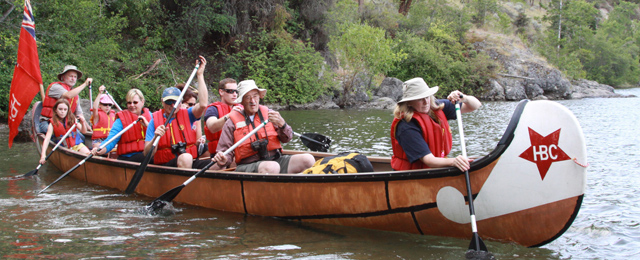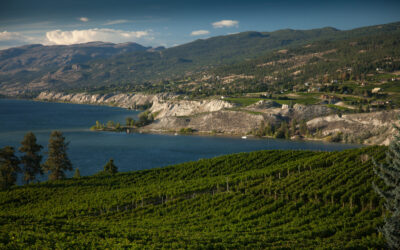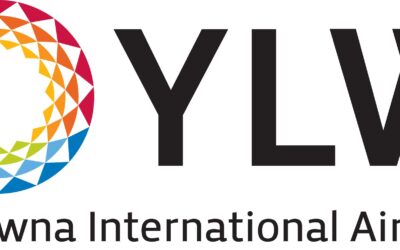
“Preparez!” I raise my paddle over the water. “En avant!” Down it goes in time with the lead stroke, Laurie Bowen, who sits alone in the bow. Jordie, her husband and partner in Selah Outdoor Explorations, is calling orders from the stern of a 29-foot freighter canoe that’s dressed in the finery of the Hudson’s Bay Company fur brigade. It’s timely that I’m paddling Okanagan Lake with the rest of the 11-person crew. This year marks the bicentennial of David Stuart’s trek through the Okanagan and the opening of a vital fur trade route that flourished for decades.
While the fur brigades made their way through this part of the Valley with unshod pack horses along the western shore of Okanagan Lake, Jordie tells us that some transport did take place by water, although the traders used smaller canoes on this route.
We’re paddling a freighter similar to those used by the voyageurs on their epic journeys through the heart of the continent. Our outing is mercifully shorter (the most strenuous work these arms have recently faced is a tussle with some weeds in the garden) so our paddle from Sutherland Park in Kelowna to the beach below Paul’s Tomb in Knox Mountain Park (about three kilometres round trip—with a head wind on the return leg) is enough for me.
Jordie keeps up a steady commentary and we concentrate on paddling in unison. We glide through a patch of tule weeds that the Syilx (Okanagan People) harvested, dried and wove into mats to make their summer dwellings. Laurie is learning the language and impresses everybody with her ability to pronounce the Syilx word for Ogopogo, n’ha-a-itk. Don’t ask me to repeat it. I still haven’t got this monster of a word.
An environmental studies and outdoor education specialist, Jordie shares info bits like the origins of the name Douglas fir (naturalist David Douglas, who rode through the Valley in 1833 with Samuel Black and who also named the ponderosa pine for its ponderous size); the effects of interrupting the region’s fire ecology (invasion of species like mistletoe and ingrowth of fir trees); and the identity of a tri-leafed bush (poison ivy—found along our trail in the park).
We beach the canoe and follow Jordie and Laurie (avoiding poison ivy, snapping photos of the mariposa lilies and walking fairly comfortably given that I’ve traded my hiking boots for a pair of water-friendly surf shoes) to a picnic site near the swimming area below Paul’s Tomb. Laurie lays on snacks and Jordie lays on history. Armed with a portfolio of historic drawings, photos and maps he shoots out a backgrounder on Rembler Paul before we climb to see the tomb he had built in 1910.
One important point about this tour is the comfort of the canoes. I’ve spent enough time with my toes curled under, knees crunched to the point of crippling inability to stand, constantly wary of the slightest weight shift in conventional canoes to really appreciate a vessel in which I can sit on a seat and feel completely solid even with a little wave action. It says a lot that I didn’t panic about carrying my anything-but-waterproof camera. The only downside was constantly paddling on the same side. But we switched positions for the return run, so both arms are equally stiff.
The tour lasts three hours and I judge it time very well spent. Laurie and Jordie named their company Selah Outdoor Explorations. Selah means “stop and consider”—right on. The couple offers three voyageur canoe itineraries: Paul’s Tomb, Rattlesnake Island and Vaseux Lake. In the winter, they switch to another quintessentially Canadian form of transport and conduct snowshoe tours at Crystal Mountain Resort. —Laurie Carter
Photos by Laurie Carter




0 Comments